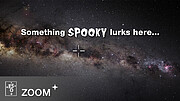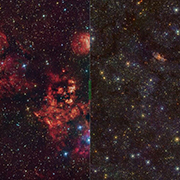
PR Video eso2518a
Fly over a spooky cosmic bat

PR Video eso2518b
Travel to a bat-shaped nebula
Located about 10 000 light-years away, this ‘cosmic bat’ is flying between the southern constellations of Circinus and Norma. Spanning an area of the sky equivalent to four full Moons, it looks as if it's trying to hunt the glowing spot above it for food.
This nebula is a stellar nursery, a vast cloud of gas and dust from which stars are born. The infant stars within it release enough energy to excite hydrogen atoms around them, making them glow with the intense shade of red seen in this eye-catching image. The dark filaments in the nebula look like the skeleton of our space bat. These structures are colder and denser accumulations of gas than their surroundings, with dust grains that block the visible light from stars behind.
Named after a large catalogue of bright star-forming regions in the southern sky, the most prominent clouds here are RCW 94, which represents the right wing of the bat, and RCW 95, which forms the body, while the other parts of the bat have no official designation.
This stunning stellar nursery was captured with the VST, a telescope owned and operated by the Italian National Institute for Astrophysics (INAF) and hosted at the ESO’s Paranal Observatory in Chile’s Atacama Desert. The VST has the perfect capabilities to capture these large spooky creatures. Onboard it is OmegaCAM, a state-of-the-art 268-megapixel camera, which enables the VST to image vast areas of the sky.
This image was pieced together by combining observations through different filters, transparent to different colours or wavelengths of light. Most of the bat’s shape, including the red glow, was captured in visible light as part of the VST Photometric Hα Survey of the Southern Galactic Plane and Bulge (VPHAS+). Additional infrared data add a splash of colour in the densest parts of the nebula, and were obtained with ESO’s Visible and Infrared Survey Telescope for Astronomy (VISTA) as part of the VISTA Variables in the Vía Láctea (VVV) survey. Both surveys are open to everyone who wants to dive deep in this endless pool of cosmic photographs. Dare to look closer, and let your curiosity be haunted by the wonders that await in the dark. Happy Halloween!
More information
Links
- Photos of the survey telescopes at Paranal
- For journalists: subscribe to receive our releases under embargo in your language
- For scientists: got a story? Pitch your research
- New ESO analysis confirms severe damage from industrial complex planned near Paranal
Contacts:
Juan Carlos Muñoz Mateos
ESO Media Officer
Garching bei München, Germany
Tel: +49 89 3200 6176
Email: press@eso.org
Bárbara Ferreira
ESO Media Manager
Garching bei München, Germany
Tel: +49 89 3200 6670
Cell: +49 151 241 664 00
Email: press@eso.org





